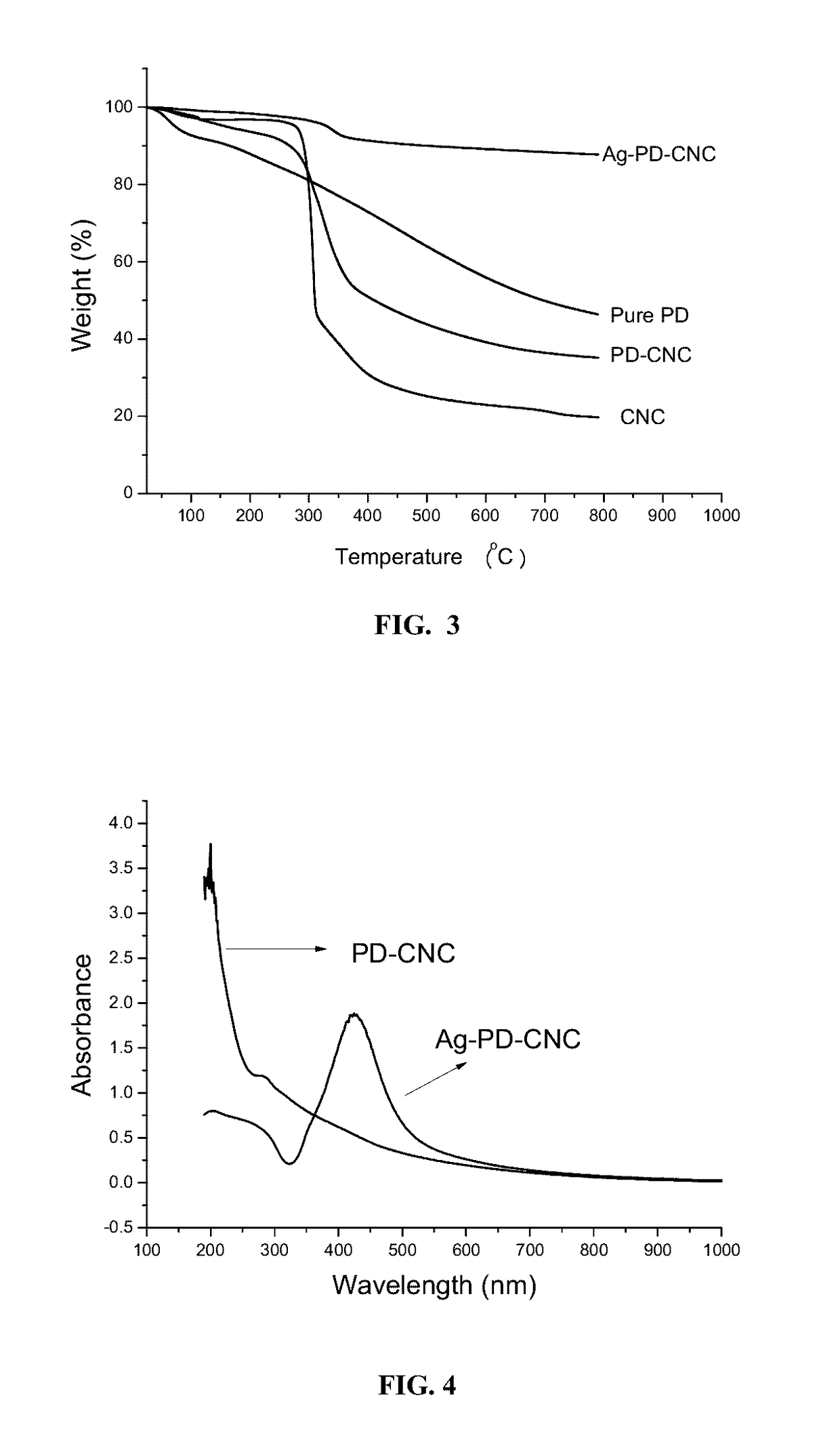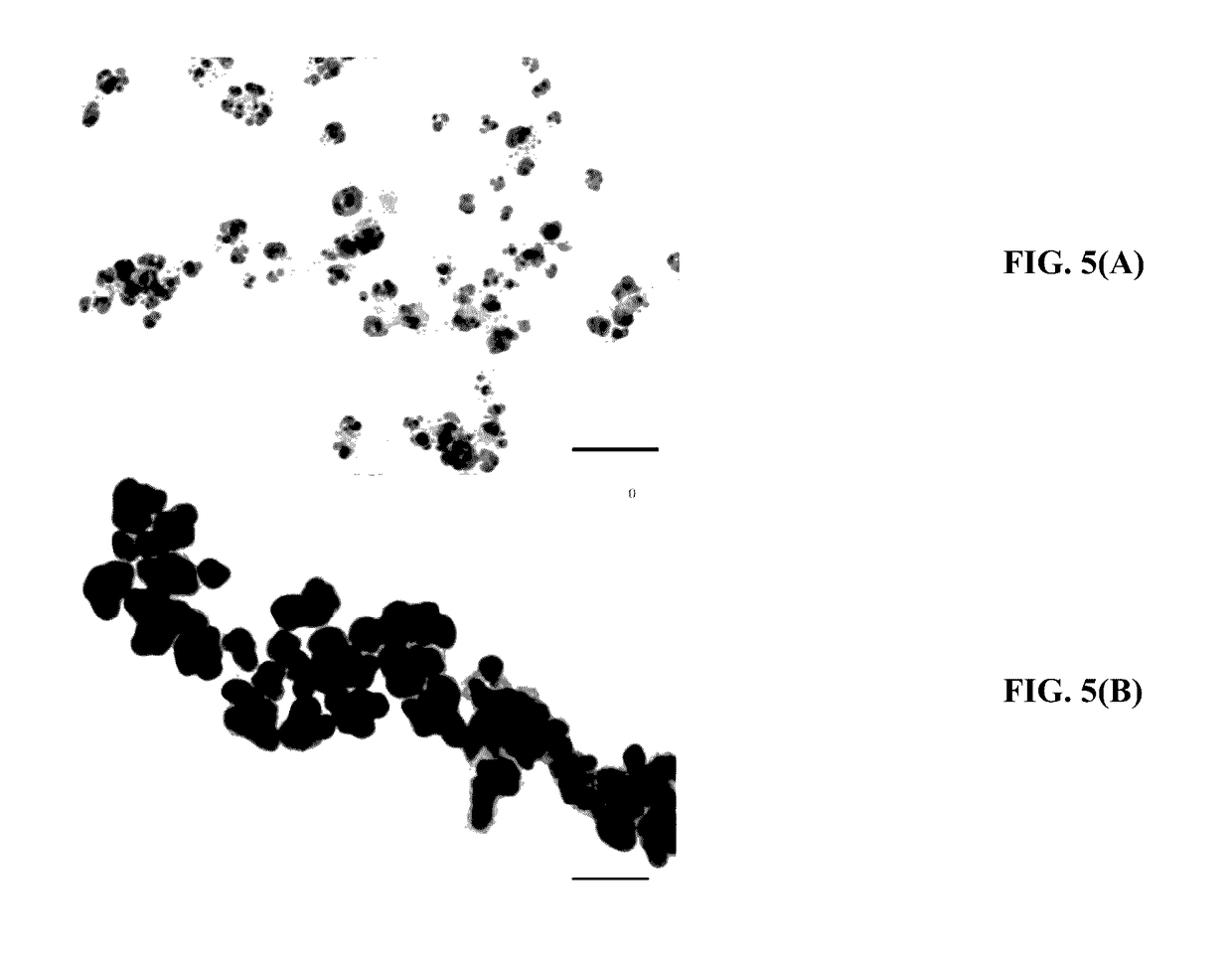Polydopamine functionalized cellulose nanocrystals (pd-cncs) and uses thereof
a functionalized cellulose and polydopamine technology, applied in the field of synthesis and use of polydopamine (pd) functionalized cellulose nanocrystals (cncs) (pdcnc), can solve the problem of non-biodegradable polymers of capping agents
- Summary
- Abstract
- Description
- Claims
- Application Information
AI Technical Summary
Benefits of technology
Problems solved by technology
Method used
Image
Examples
example 1
PD Functionalization of CNCs I
[0082]The coating process is as follows: 1.0 g of CNC was dispersed in 500 mL deionized water using Branson™ 1510 sonicator (Branson Ultrasonic Corporation, USA) for 15-20 minutes, and 0.6 g of tris((hydroxymethyl)aminomethane) was introduced into the CNC solution to adjust the pH to ˜8.0. Then 1.0 g of dopamine hydrochloride was added. The reaction was performed at room temperature for 0.5-3 days (preferred 1-2 days) under ambient atmosphere. At the end of the reaction, the products were purified in an ultrafiltration cell equipped with a 0.1 μm pore size filtration membrane and they were washed several times with 200 mL deionized water until the filtrate became clear. Pure polydopamine (PD) was prepared at the same condition without CNC. The resultant PD was purified by dialysis against deionized water for 7 days with a dialysis tube (cut-off molecular weight is 12,000), and then dried in a vacuum oven at 60° C. for 24 h.
[0083]The schematic representa...
example 2
PD Functionalization of CNCs II
[0085]Another typical procedure is described as follows: 1.0 g of CNC was dispersed in 100 mL deionized water using the above sonicator, and 0.3 g of tris((hydroxymethyl)aminomethane) was introduced into the CNC solution to adjust the pH to ˜8.0. Then 1.0 g of dopamine hydrochloride was added. The reaction was performed at 60° C. for 1-5 hours (preferred 3 hours) under ambient atmosphere. At the end of the reaction, the products were purified in an ultrafiltration cell equipped with a 0.1 μm pore size filtration membrane and they were washed for couple of times with 100 mL deionized water until the filtrate became clear.
example 3
Fabrication of A2NPs Immobilized CNCs
[0086]Fabrication and Immobilization of AgNPs was achieved by the following two-step protocol: First, 50.0 mg of silver nitrate was introduced into 20 mL deionized water, and then ammonia in water solution (3.0 wt %) was slowly added to the above sliver nitrate solution until the solution became clear indicating that the diamine silver (I) was formed. Then 0.5 mL of PD-CNC solution (3.0 wt %) was added to the resultant diamine silver (I) solution and stirred at RT for 1 h followed by the addition of 4.0 mg of dopamine hydrochloride (in 1.0 mL deionized water) that facilitates the reduction of silver ions. After 0.5-5 hours (preferred 1-2 h), the product was purified by centrifugation at 8000 rpm for 10 min, then washed with deionized water for 3 times. The final product was characterized by TGA (FIG. 3), UV-Visible Spectroscopy (FIG. 4) and TEM (FIG. 5a). The successful generation of AgNPs was confirmed by UV-Visible spectroscopy as shown in FIG....
PUM
| Property | Measurement | Unit |
|---|---|---|
| Concentration | aaaaa | aaaaa |
| Metallic bond | aaaaa | aaaaa |
Abstract
Description
Claims
Application Information
 Login to View More
Login to View More - R&D
- Intellectual Property
- Life Sciences
- Materials
- Tech Scout
- Unparalleled Data Quality
- Higher Quality Content
- 60% Fewer Hallucinations
Browse by: Latest US Patents, China's latest patents, Technical Efficacy Thesaurus, Application Domain, Technology Topic, Popular Technical Reports.
© 2025 PatSnap. All rights reserved.Legal|Privacy policy|Modern Slavery Act Transparency Statement|Sitemap|About US| Contact US: help@patsnap.com



